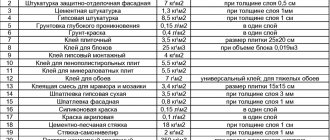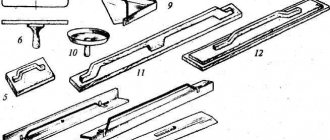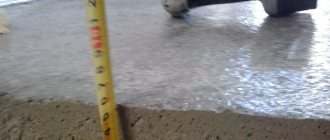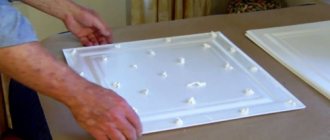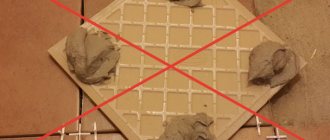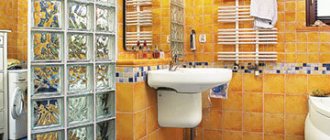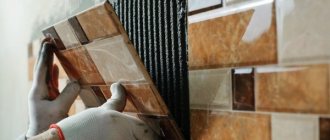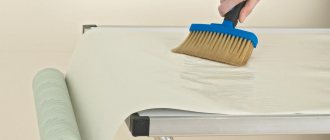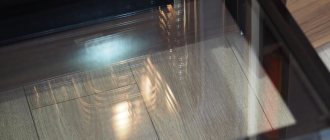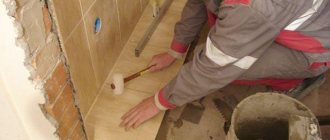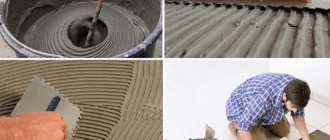The tiles have been chosen, a beautiful and original design has been invented, all that remains is to bring everything into reality. Last purchases left: how much tile adhesive is needed?
The answer directly depends on the thickness of the layer of tile adhesive that will be used during installation. What factors affect the thickness of tile adhesive and how to use it correctly?
You shouldn’t naively believe that the more, the better. If the maximum permissible thickness of tile adhesive is exceeded:
- the cladding will not adhere securely, as a result, the durability of the coating will decrease;
- glue consumption will increase, which will lead to unnecessary costs.
Permissible maximum and minimum thickness
You can lay tiles with different types of glue and different thicknesses, but there is a range beyond which experts do not recommend.
First of all, the indicators will depend on the type of tile and the size of one element.
On small tiles, it is recommended to apply a layer of adhesive no more than 2 mm - it will be enough to fix the ceramics. If the tile is thick and massive, it is better to make a larger layer - up to 4-5 mm.
First of all, this applies to materials such as porcelain stoneware.
An increase in the average parameters can only be justified by the desire to level out the relief of the rough surface. In this case, you should evaluate all the irregularities and bring out the highest point - here the layer of glue will be minimal.
In this case, you must adhere to the maximum values of the adhesive layer:
- for ordinary wall tiles – 10 mm;
- for floor tiles – 15 mm;
- for porcelain stoneware – 20 mm.
If there is a need to lay an even thicker layer, it is better to level the surface with the solution, and after it dries, do the lining.
Laying tiles on walls
Let's look at how to properly apply the solution to the walls. For standard wall tiles, the thickness of the tile adhesive should be approximately 4-5 mm. In order to install it correctly, you must first level the corners and smooth out the main irregularities using plaster.
It is best to start laying from the bottom at the level of the second row. Its position must be calculated in such a way that in the end all the upper rows consist only of solid elements, not taking into account the outer tiles.
Laying tiles on walls is done from bottom to top; the thickness of the adhesive for standard wall tiles is 4-5 mm
The glue is applied to the wall itself, and the area to be treated should not occupy more than the size of three or four cladding elements. If you need to tile hard-to-reach places, for example, corner areas, it is best to spread the glue on the tile itself so that you can evenly distribute the grooves on it. To adjust the thickness of the mortar layer, you need to gently press and tap the tile. After this, the seams are set, the level is checked and all excess is removed.
Composition of adhesive
The thickness of the adhesive layer is determined by the composition of the glue itself and the presence of various additives in it. There are three basic types of cladding products:
- cement mortar - produced in the form of a dry mixture based on Portland cement, sand and plasticizers. The solutions firmly hold the tiles on the surface, but are characterized by high consumption;
- two-component products - made on the basis of epoxy resin and catalysts. This is a viscous adhesive with increased fixation properties and minimal consumption;
- dispersion agents - their composition includes resin and polymer components. They are used sparingly, but the maximum and minimum layer thickness is calculated individually for each surface and type of ceramic tile.
Advice! More details about the rules of preparation and application are indicated in the instructions for the glue. But you need to keep in mind that manufacturers make recommendations only for a perfectly flat surface.
What to consider when choosing ceramic tiles
There are some secrets that are worth knowing when choosing ceramic tiles:
- Tiles of small sizes will be a rational choice for rooms with small areas; it will help to visually expand the room, making it more impressive and visually attractive. In this case, you can choose tiles: 2.5x2.5 cm, 5x5 cm, 10x10, 13x13 cm, 20x20 cm, 30x30 cm, 40x40 cm.
- If the room has large areas, then cladding material of larger sizes 60x60 cm, 60x120 cm, 120x120 cm is suitable. Most often, such tiles can be bought directly from the manufacturer, since they are not popular in construction stores and therefore it is very difficult to find them there.
The thickness of ceramic tiles with adhesive is best leveled using modern laying systems.
When choosing tiles, it is worth considering that the durability of the facing material is very important for the floor:
- 8 mm is considered the minimum thickness in the finishing of a residential building. This type of tile has a relatively low cost and copes well with the weight of a person and furniture.
- 12 mm - this option can be chosen for public places, as it is durable. Most often it is used for living rooms and corridors.
- 16 mm - such tiles can be used for cladding industrial premises where there may be maximum loads. This material is highly durable, very expensive, and people try to use it only in special cases.
The thickness of ceramic wall tiles is not as important, so strict requirements do not apply to it. Most often, small wall tiles have a thickness of 3 to 4 mm. Standard tiles can be from 4 to 9 mm.
If you choose thin tiles, they may turn out to be fragile; thick ones have a lot of weight and glue consumption will increase significantly. In this regard, experts recommend choosing facing material of standard thickness - 7 mm. This material will last quite a long time and is easy to install.
The visual effects of tile thickness can be seen in the photo:
The thickness of ceramic tiles can be leveled using an adhesive layer; in this photo, all interiors have no flaws, because all installation was done by professionals
Tile thickness depending on type and conditions of use
When facing walls and floors, it is necessary to take into account such parameters as the type of material and the conditions of its use.
The thickness of the adhesive along with the tiles will differ for tiles, wall, floor and ceiling coverings.
Tile
The thickness and dimensions of the tiles are very diverse - from 4 mm to 2.5 cm. For use in domestic conditions (finishing a bathroom, shower, kitchen), thin tiles with a thickness of 4-9 mm will be sufficient.
It is considered optimal for city apartments and country houses, especially if mounted on a wall surface
.
In industrial construction, when arranging the flooring of workshops and industrial premises, very durable elements are used, the thickness of which reaches 2.5 cm. They are designed to withstand significant loads and temperature changes.
The amount of glue here will also be maximum.
Flooring
As a rule, floor tiles are thicker than wall tiles. This is due to the increased load that the tiles experience.
The minimum layer of such coating is 8 mm - it is advisable to use it in rooms with low traffic and light load. Floor tiles whose thickness ranges from 9-11 mm have optimal performance.
It can be used safely in residential premises.
If high loads on the floor and high traffic are expected, it is worth choosing tiles with a thickness of 12 mm.
Important! The larger the area of the tile elements, the greater the consumption of adhesive should be planned. For large tiles 300*300 mm, the adhesive layer should be 7-9 mm on a flat surface.
Wall covering
There is no point in tiling the wall with tiles that are too thick - holding it in place will require more glue consumption, which will reduce the quality and reliability of the finish. Therefore, the optimal thickness of tiles for the wall is 4-9 mm.
When facing walls indoors, it is recommended to apply adhesive to tiles with a thickness of 3-5 mm. Changes in layer thickness will be determined by the quality of the surface and the material from which the tile is made.
The maximum layer of wall tiles with sides of 20 cm and 25 cm must be laid.
Ceiling tiles
Ceiling tiles place special demands on both the material of manufacture and the adhesive. The ceiling lining, more than any other, is affected by the force of gravity, so it must be very thin and lightweight.
That is why polystyrene foam tiles are mainly used for ceiling finishing:
- extruded – thickness from 2.5 to 3 mm;
- injection - 9-14 mm.
Any synthetic glue is suitable for their installation, and it can be applied in a very thin layer of a couple of millimeters.
The nuances of determining the thickness of glue on the floor
If decorative segments are laid on the floor, then you need to take into account that heavier and larger tiles are used. Therefore, the volume of the composition for laying when installing tiles on a horizontal plane is approximately 1.5 times greater. And the thickness of the adhesive for porcelain tiles on the floor is 2 times greater.
There are several features when installing finishing on a “warm floor” system:
- If electrical cable mats are used, the height of the interlayer will depend on the size of the cable. On top of the mat, provide an adhesive mass of 5-6 mm.
- If installation is carried out on infrared panels, then the distance from the surface of the base to the upper edge of the decorative segments is left 30 mm. Therefore, the consumption of fasteners will depend on the thickness of the tile.
Calculation of the amount of adhesive
When purchasing facing material, it is recommended to immediately purchase the required amount of ready-made adhesive or dry mixture.
To calculate it, you need to take into account several factors and at the same time focus on the data specified by the manufacturer.
What affects the thickness of the adhesive layer?
First of all, the area of the tile element is taken into account:
- 50*50 mm – 3 mm glue;
- 10*10 cm – 4 mm glue;
- 150*150 mm, 100*200 mm – 6 mm;
- 20*25 cm – 8 mm;
- 30*30 cm – 10 mm of adhesive mixture.
The quality of the coating on which the tiles are mounted is of no small importance. To fix tiles on smooth walls or on a floor without defects and a large number of pores, you will need less glue than for uneven porous surfaces.
Important! Before laying, it is necessary to completely clear the floor and walls of dust and debris - they impair adhesion and increase the consumption of the installation compound.
In general, the algorithm for calculating the amount of glue looks like this:
- Take the dimensions of the purchased tiles and select the optimal layer of mortar indicated on the package.
- Find on the packaging indicators of glue consumption per 1 m2 with a layer of 1 mm.
- Multiply the layer indicator (from point No. 1) and the flow rate (from point No. 2). You will get an intermediate version of the adhesive consumption per 1 m2 of decor area.
- Calculate the total area of the facing surface.
- Multiply the resulting number of square meters with the glue consumption per 1 m2. This is the total cost of the solution.
- The final result must be multiplied by 1.1 - this is a 10% margin, which in most cases will be needed due to calculation errors and changes in surface quality.
Humidity and moisture absorption
When solving the problem of calculating glue consumption, you should take into account 2 more indicators:
- moisture absorption of the facing surface;
- humidity of the solution.
When laying tiles on the wall, it is prohibited to use semi-dry mixtures, otherwise a strong adhesion will not be obtained. If the wall is too porous and rough, it is recommended to prime it in several layers until the increased moisture absorption of the area stops.
If absorbency persists, you will have to increase the thickness of the installation layer, otherwise the tile simply will not stick.
When arranging the floor, it is allowed to prepare a drier solution, but only if the floor base does not have increased moisture absorption. Nevertheless, the solution must be sufficiently plastic and easily distributed over the surface.
In some cases, the use of a primer layer is also indicated.
Calculation of required volume
The adhesive solution, that is, its weight, is measured in kilograms (kg). To calculate the maximum volume of mixture required for the entire repair, first determine the amount of glue that will be required to lay tiles on 1 square meter of base area. After which the found figure is multiplied by the total number of meters of area.
To clarify the thickness of the tile mortar and its required mass for the entire volume of the tile, it is necessary, based on the initial data, to perform calculations in several steps.
- Determine the dimensions of the elements and select the optimal thickness of the mortar for them, taking into account the characteristics of the base being coated;
- The packaging of the mixture for injecting the solution must contain information about how many kg of the mixture is consumed to cover one square meter with a minimum thickness of 1 mm;
- Next, these two found values are multiplied, the intermediate result becomes known - the volume of the mixture to finish a meter of square area;
- After which they are determined with the total area of the base to be finished;
- Multiply the first total value by the number - square footage;
- In case of force majeure, you must always have a certain amount of the mixture in stock. Why is the final value in the last paragraph multiplied by a factor of 1.1. This will allow you to add 10 percent to the estimated volume for the reserve.
How to use the solution correctly?
To apply the product you will need two types of spatulas:
- regular smooth for mixing and scooping up adhesive;
- toothed to distribute the composition over the surface.
The key point is proper preparation of the solution. Experienced craftsmen advise mixing a thicker mixture, and then bringing it with water to the desired plastic consistency.
After 10-15 minutes, when the solution has settled and acquired viscosity, you can begin application.
Use a smooth spatula to scoop out a small amount of glue. Part is applied to the surface of the cladding, part is applied to the back side of the tile. Then, using a notched trowel, “smooth” the layer on the tile, distributing the glue over the entire area of the element and achieving the adjusted thickness. Excess composition is removed from the edges and sent to a common container with the solution.
Advice! When applying glue to the wall, you should cover an area of no more than 2-3 elements. The mixture should lie evenly and fill all uneven areas.
Why choose the thickness of ceramic tiles
The correctly selected thickness of tiles or porcelain tiles will help anyone who decides to make repairs to increase the service life of the finishing material and save money. After all, it’s not always worth overpaying for extra dimensions, which can interfere with the quality of the cladding.
A small thickness will make a neater seam and last longer on the wall. And larger values are better suited for floors that experience heavy loads and will make it stronger. Some more nuances can be seen in the video below:
Spatula teeth size
The amount of mortar on the tiles and wall will directly depend on the height of the trowel-comb teeth. The thickness of the final adhesive layer will be approximately half the height of the teeth - that is, to get a layer 4 mm thick, you need to choose a spatula with 8 mm teeth.
When working with tiles that have a grooved pattern on the back, you should also take into account its depth, since the teeth will fit into the grooves. The greater their depth, the greater the height of the teeth the tool should have.
The composition of the glue also determines the height of the teeth. Since cement mortars are applied in a thicker layer, it makes no sense to use low tines. And vice versa - for synthetic mixtures, low teeth that create a thin layer are just right.
Experienced builders emphasize the importance of preliminary preparation of walls and floors before facing work. A smooth surface impregnated with a primer will take less glue, the coating will be even, with minimal risk of cracking and distortion.
Additional dependencies
It is also worth considering other factors, since the size of the tile itself is not the only one among them. For example, when laying porcelain stoneware, the layer will be larger than when using tiles. In addition, it is important to consider where the tiles are laid, on the floor or on the wall. Thus, the thickness of the adhesive layer when laying tiles on the floor will be several millimeters greater than when working with wall cladding.
In addition, the base itself also affects the thickness of the tile adhesive. If the base is made according to the level, without any defects, then the thickness will remain unchanged. If they have any bulges, pits or other defects, then the thickness in some cases will need to be reduced, and in some places increased. Although, if there are defects, high-quality masonry is out of the question, so it would be advisable to perform leveling in order to save effort, time and financial costs, since the cost of glue is somewhat more expensive than mixtures for leveling.
The surface of the material also becomes an important factor. In some cases, porcelain tiles may have distortions, i.e. convexity or convexity in its surface. In such a situation, it is necessary to provide the same layer (no more than 10 mm) at the extreme points, and adjust the central one to the edges.
Overview of methods
About values
The thickness of the adhesive during installation may vary during the process, but there are certain limitations. In order for the layer to be uniform and correct, it is worth relying on the so-called minimum and maximum limits.
Everything should be measured
The calculation is made individually depending on the size of the tile or tile made of another material. For small and relatively light elements, the layer is made up to 0.2 cm. In cases where the element is massive and heavy, a thickness of up to 0.5 cm can be used.
Often there may be a need to level the surface without screeding or using additional materials. To do this, you can mark the maximum point and apply a layer of adhesive up to 1-2 cm into the pits, near the tubercles, etc. You should not use the composition excessively, because a large amount of glue on the floor will reduce adhesion and density. In addition, overspending is not advisable from a cost point of view.
Why is it sometimes done with a thick layer of glue?
The main reason is poor preparation of the base:
- Some people prepare the screed or plaster, and others do the cladding. Their quality requirements and interests are different. With this approach to business, there will always be conflict.
- Using a faulty measuring instrument when constructing planes (levels, lasers, levels). Who checks their laser or level before starting work every day? There is no such person on the planet. The error becomes noticeable during cladding or when checking the finished plane. This is not only a problem for cladding work. Installed windows, socket boxes or sanitary appliances using uncorrected tools come into conflict with subsequent finishing.
- An attempt to make a slope when lining a balcony or terrace using a layer of glue.
- Laying tiles along a heating cable on a layer of adhesive. (This technology is advertised mainly by sellers of such systems.)
Also, laying in layers is typical for those who like to use a level while working. It always remains a mystery to me what they want to see there.
In 90% of levels, the bubble is knocked down or it is difficult to accurately catch the center on it. And if you expand this level, the readings will be different. How to determine which side to look at? With this method, the layer grows gradually and imperceptibly. It is no longer possible to jump off it abruptly.
I can agree with this technology if a 3-meter wedge is used to control the plane. And place it at reference points.
